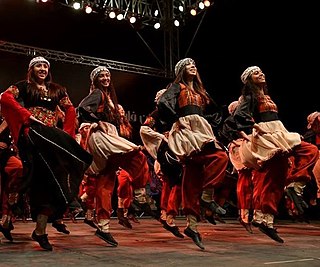Dabke (Arabic: دبكة) is a traditional folk dance in the Middle East. It started in the Levantine region that includes Palestine, Lebanon, Jordan, and Syria. The word "Dabke" comes from the Levantine Arabic word "dabka", which means "punching of the feet" or "to make a noise". It involves repeated pattern of movement or sound. It is performed in a group by men or women, mostly at weddings, celebrations, and cultural events. Dabke is a important part of the cultural heritage of these countries. Cultural heritage festival is a celebration where people come together to show and celebrate their History and action or way of behaving that is common among them. It brings people together and make them enjoy their shared identity and joy.[1][2]

History
changeDabke dance has a old history that dates back centuries in the Levantine region of the Middle East, especially in countries such as Palestine, Lebanon, Jordan, and Syria. It started as a traditional folk dance among group of people living in these mountainous areas. Palestinians who study and document traditional ways of celebrations like Abdul-Latif Barghouthi and Awwad Sa'ud al-'Awwad believe that the jumps in dabke dance might have started long ago in ancient Canaanite rituals. These rituals were about helping the crops to grow, scaring away the bad spirits, and keeping the plants safe.[3]
Variations
changeThe dance involves rhythmic stomping of the feet (to walk with heavy steps), organised movements, and energetic footwork. It has both the circle dance and line dancing. Dabke is mostly performed along with traditional music, including drums, flutes, and other instruments. The movements of the line are led by a laweeh. Laweeh is a dancer who stand in the front and starts the changes in line formation. He is then followed by a group of singers.[4][5]
Dabke is performed indoors as well as outdoors, on a stage or sometimes just on the ground. The dance has different steps called belbel, inzel, shemmel, etc. People do a mix of these steps, along with some jumps and turns, to complete the dance.[6]
Different types of dabke can be found across different regions and communities. In Lebanon, Dalouna is the most common type of dabke. It has six beats and is usually joined by a minjeira (flute) or mizmar (copper flute) and darbuka (goblet drum).[7] Jordanian dabke often features slower, more calculated movements, reflecting the country's Bedouin history.[8]
Despite these differences, dabke is a cultural symbol and popular practice that unites people who have grown up in the Levant.[5]
World records
changeOn 7 August 2011, a group in the Lebanese village of Dhour El Choueir set a new world record. Organized by the Dhour El Choueir Summer Festival, a human chain of 5,050 was made and currently holds the world record in the Guinness Book of World Records.[9]
References
change- ↑ "The Art of Dabke". Bayt Al Fann. 25 July 2022. Retrieved 10 February 2024.
- ↑ Cohen, Dalia; Katz, Ruth (16 January 2006). Palestinian Arab Music: A Maqam Tradition in Practice. University of Chicago Press. ISBN 978-0-226-11298-5. Retrieved 10 February 2024.
- ↑ Kaschl, Elke (2003). Dance and Authenticity in Israel and Palestine: Performing the Nation. Brill. p. 82. ISBN 9789004132382.
- ↑ "The beat goes on: The story of Palestine's national dance". +972 Magazine. 20 September 2017.
- ↑ 5.0 5.1 "Arab expats share their love for the Levantine folk dance". Gulf News. 23 August 2022.
- ↑ "Dabke appeals to Westerners, Arabs alike". The Arab American News. 3 May 2008.
- ↑ karenkaram (2 June 2016). "The Dance". 365 Days of Lebanon. Retrieved 10 February 2024.
- ↑ Jordanian Dabke YU | دبكة أردنية - فرقة جامعة اليرموك, retrieved 2024-03-11
- ↑ "The Largest Dabke Dance". Guiness World Records.